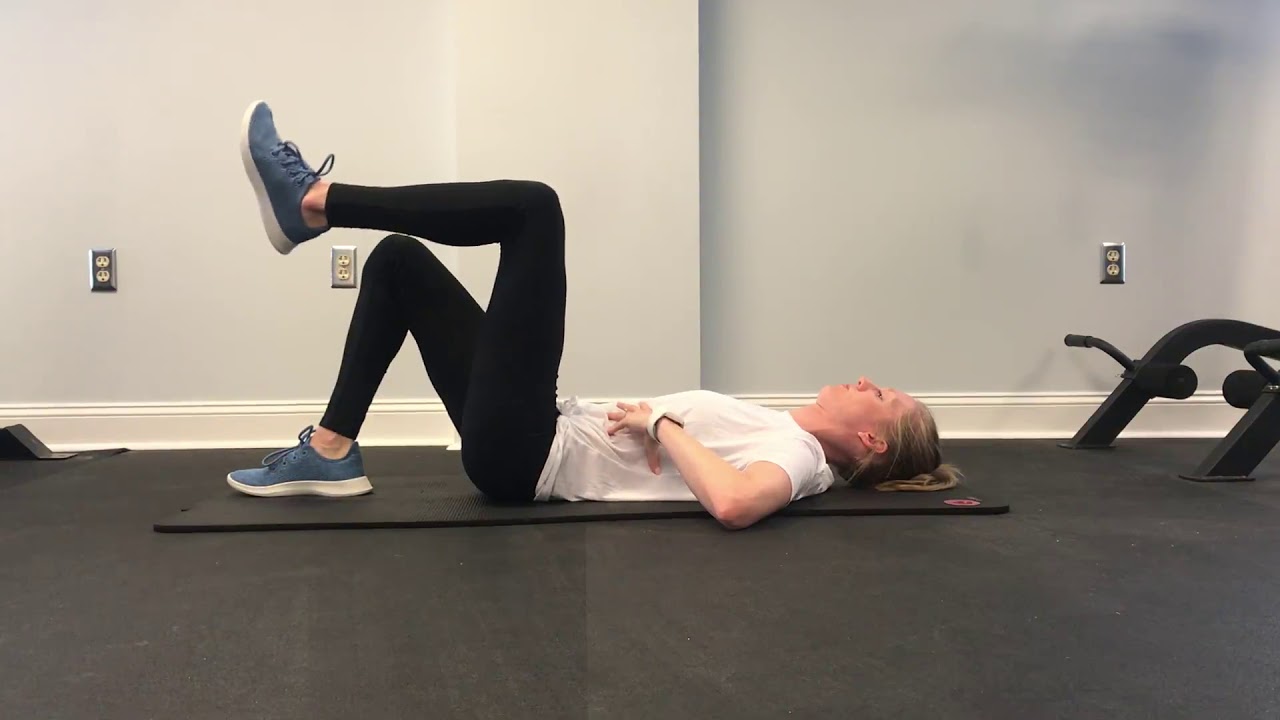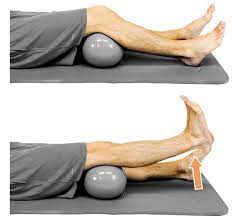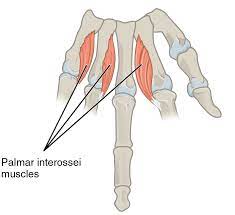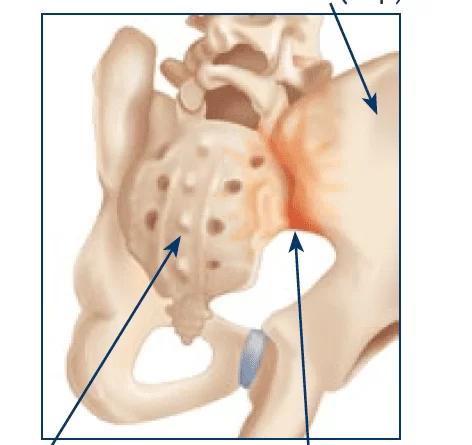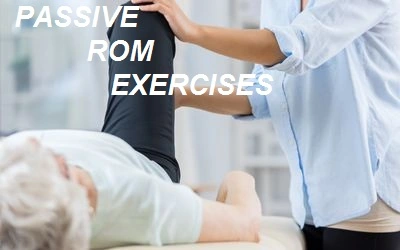Transverse abdominis muscle strengthening exercise
Table of Contents
What is the transverse abdominis?
- Transverse abdominis strengthening exercise is an important way to make the abdominal wall stronger as well powerful with too many health benefits associated with this.
- The transverse abdominis is the deepest muscle in the abdomen region. This would not give the patient the much-desired six-pack look but this unsung hero of the abdominal muscles, this muscle acts as a natural lifting belt keeping the abdominal organs protected & giving support to the pelvic and lumbar regions as well. The transverse abdominis muscle is most important for moving the trunk.
- It is a lesser-known muscle found on an anterior side of an abdominal wall under the internal oblique muscle. The transverse abdominis muscle is referred to as the transverses muscle & abbreviated as the TVA.
- This muscle gets its name from its muscle fiber direction, as they are laid out horizontally in an abdominal region. These flat muscles have more than one origin, arising from the anterior two-thirds of the iliac crest & lateral third of the inguinal ligament as well as iliac fascia, thoracolumbar fascia & finally the inner surface of the lower 6 costal cartilage of the lower 6 ribs.
The action of the transverse abdominis
- This is an essential muscle in the core that provides stability to the spine as well as the pelvis so that motion of the limbs is possible by supporting the trunk hence maintaining abdominal wall tension. The transverse abdominis muscle also protects internal organs & holds them in place.
- Sometimes mentioned as a “corset muscle” the transverse abdominis supports our body’s core by wrapping around our sides. Transverse rotation is part of daily life as we twist & turn constantly a strong, as well as healthy transverse abdominis, is paramount.
How does the patient activate a transverse abdominis muscle?
- This muscle activation is not straightforward due to the deep location in the abdomen. To get an idea of how to activate it you have to lie down on the back with your knees flexed as well as your feet flat on the floor. Take the hands as well as feel the area of the lower abdomen by the pelvic bone. From here the patient can engage the transverse abdominis & slowly draw in the area of the lower abdomen. Try to breathe normally in this position as you keep the muscles contracted.
- Another method of activating & engaging the transverse abdominis is by bracing the core. To do this take a deep breath then tighten the abdomen region like the patient is bracing for impact. the patient should be able to continue to breathe normally with the muscles contracted.
How does the patient know if he has a weak transverse abdominis?
- A strong core allows the patient to do daily activities with a low risk of injury. To gauge the core’s strength, he can perform a few easy self-tests to determine the patient’s transverse abdominis. Try to do some exercises like glute bridges or leg raises and if he has any pain in the lower back area the patient might have weak transverse abdominis muscles.
Here are four signs that the core might be weak:
- The patient has to use the arms or hands to help get out of the chair or even bed.
- When walking the patient swayed back & forth he holds his breath.
- When performing core exercises, the lower back is arched when he is standing or walking.
Why is it important to have a strong transverse abdominis?
- Being the deepest layer of the abdominal muscle, the transverse abdominis plays an essential role in preventing our bodies from moving in improper ways.
- This is important to have a strong transverse abdominis owing to if this muscle is weak then it may not properly support the pelvis & spine hence leading to lower back pain. By keeping the pelvis in a neutral position & your lumbar spine supported, a strong transverse abdominis muscle can prevent back pain.
Health benefits of Transverse Abdominis strengthening exercise
- This may help decrease back pain, lower the risk of injury, & in some cases, make the waist appear smaller.
- Lower risk of injury
- This May helps the waist look smaller
- This exercise Supports Better Posture
- This exercise to Improve Balance
- This exercise Supports Good Running Form “Core strength allows the hips, pelvis, & lower back to work together more smoothly with less rocking and less excess energy expended too.
- This exercise Improve Stability If the patient has a weak core, he instantly heightens the risk of muscle injuries, lower back pain, & poor posture.
- Helps to Protect the Organs.
- Helps to Make Life Easier: Like bending down to pick something off the floor, long time standing, or performing household chores.
- That is why many core exercises fall under an umbrella of functional fitness: They can help you go about the day with more easiness, and seriously makes the patient more functional.
- Helps to reduce or Prevent Low Back Pain.
- Helps to Boost Your Power.
- Helps to Support Strength Training.
- This exercise helps the patient Age Well: This stabilizes the whole body & gives you better balance and posture, all of which may help you to prevent falls, prevent back pain, & keep you mobile as you get older.
- Helps to increase spinal mobility.
- However, abdominal exercises may help to tone the belly somewhat by defining the abdominal muscles. And once you lose the tummy fat, you will likely discover that you have that six-pack hiding underneath.
- Many individuals aspire to gain stronger, leaner abdominal muscles (or abs).
Different types of exercises strengthen the Transverse Abdominis muscle
Hollow Body Hold
- How to do this strengthening exercise:
- To do this exercise the patient has to Lie on the back with the arms as well as legs straighten.
- Engage the abdominals & glutes lifting the legs off the ground.
- Raise the shoulders off the ground keeping the arms extended.
- Hold this position as much as you can. Hold for 15 to 25 seconds then come back to the initial position. Complete 2 to 3 sets of 10 to 20 repetitions.
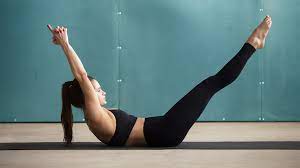
Bird Dogs
- How to do this exercise: To do this exercise the patient has to Get on the four limbs, hands under the shoulders, & knees under the hips
- Extend the right arm up in front of you while simultaneously lifting the left leg behind you, the back should be straight
- Hold this position for two seconds.
- Do this on another side. Do 2–3 sets of 8–10 repetitions on both sides.

Bird Dog Knee to Elbow
- How to do it: To perform this exercise a patient has to Get on the four limbs, Get on the hands & knees with the hands under the shoulders as well as knees under the hips.
- Extend the right arm up in front of you while simultaneously lifting the left leg behind you keeping the back straight.
- Contract the abdominals to bring the right elbow to the left knee, meeting in the center of the body.
- Reverse the motion, extending the arm & leg.
- Switch sides. Do 2 to 3 sets of 8 to 12 repetitions.
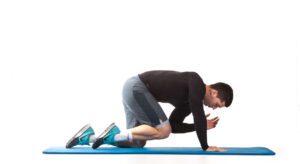
Dead Bug
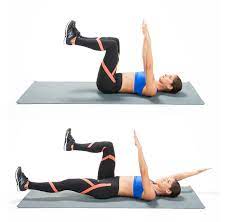
- How to do this strengthening exercise: To do this exercise the patient has to lie on the back & extend the arms toward the sky with the legs up, the knees should be flexed so that the calf is parallel with the floor.
- Slowly extend the right leg out during lowering the left arm overhead until both are a few inches off of the ground.
- The core should be engaged throughout the motion bringing both arm & leg back to the starting position.
- Repeat this with the other side. Do 2 to 3 sets of 10 to 12 repetitions.
Forearm Plank
- How to do this strengthening exercise: To do this exercise the patient has to come into the plank position on the floor with the legs extended behind you & the hands stacked under the shoulders.
- Lower down onto the forearms. The body should be straight by engaging the core, glutes as well as, and quadriceps.
- Hold this position for 40-60 seconds. Do two to three sets of 10 repetitions.

Shoulder Tap Plank
- How to do this exercise: To do this exercise the patient has to come into the plank position on the floor with the legs extended behind you & the hands slightly wider than the shoulders.
- The body should be straight by engaging the core, glutes, & quadriceps muscles.
- Reach up & across the body to touch the opposite shoulder then place the hand back on the floor.
- Switch sides with the other hand & shoulder. Start with 2 sets of 8–10 repetitions on both sides.

Knee Tap Plank
- How to do this exercise: To perform the knee tap plank exercise the patient has to come into the plank position with the legs extended behind you and the hands stacked under the shoulders.
- The patient’s body should be straight by engaging the core, glutes, and quadriceps as well.
- Slowly lower one knee at a time to touch the ground then extend it back up.
- Switch sides with the other leg. Embark with 2 sets of 8–10 repetitions on both sides.

Plank to Side Plank

- How to do this strengthening exercise: To perform plank to side plank you first achieve a plank position with the legs extended behind you & the hands stacked under the shoulders.
- The body should be straight by contracting the core, glutes, and quadriceps too.
- Slowly rotate the body into the side plank move the arm up towards the sky, & hold for a two-second.
- Switch sides with the other arm. Start with 2 sets of 8–10 repetitions on both sides.
Up and Down Planks
- How to do this strengthening exercise: To do this exercise first come into the plank position.
- Slowly lower one arm placing the forearm on the ground.
- Then lower the other arm placing the other forearm on the ground.
- Press up one arm at a time bringing you back to the plank position.
- Do 10 repetitions starting with the left elbow.
Front Plank with Arm/Leg Lift
- How to do this exercise: To perform this strengthening exercise, first come into plank position with hands stacked under the shoulders, raise the opposite leg & arm straight in front/back of you.
- Slowly lower to starting position. Repeat for 10 to 15 repetitions & then repeat on the other side.
- Do this on another side. Repeat for 10 to 15 repetitions & then repeat on the other side.
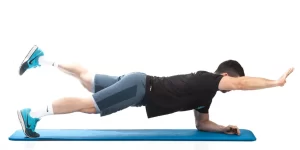
Air Bike
- How to do this strengthening exercise: To perform this exercise the patient has to take a supine lying position then bring the legs up with the knees flexed up to 90 degrees and the hands behind the head.
- Extend one leg during curling up touching the elbow to the flexed knee.
- Then bring the leg back & extend the other while touching the other elbow touches to the opposite knee.
- Make sure the core should be engaged throughout the motion. Begin with 2 sets of 8–10 repetitions
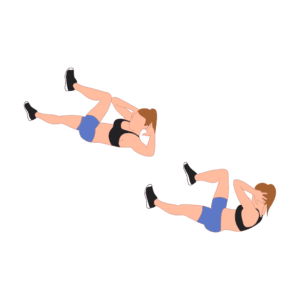
Corkscrew
- How to do this strengthening exercise: To perform this exercise the patient has to take the supine lying position with the hands by the sides.
- Extend legs up off the ground up to 90 degrees.
- Lift the lower back off the ground bringing the feet over the head then swing the legs in a circular movement keeping the core engaged throughout the motion.
- Repeat for desired reps.
- Switch directions of the motion and complete the same amount of repetitions.
- Start with 2 sets of 8–10 repetitions.
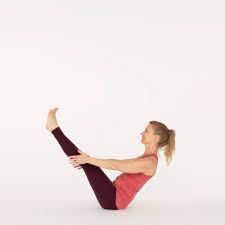
Wipers
- How to perform this strengthening exercise: To do this exercise the patient has to take a supine lying position.
- Bring the legs up so that the feet are pointing to the sky.
- Brace yourself with the arms on the floor to the sides.
- Slowly lower the legs to the side of the body keeping the lower back in contact with the floor. Touch the feet to the ground then swing the legs to the other side touching the floor.
- Start with 2 sets of 8–10 repetitions.
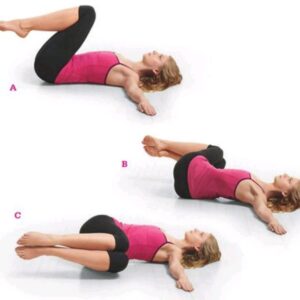
Hundred
- How to do this strengthening exercise: To perform this exercise the patient has to Lie down on the back, the legs extended with the arms over the head Raise the legs to a 45-degree angle.
- Curl up as well as bring the arms towards the toes also at forty-five degrees.
- Bring the arms back to over the head.
- Repeat for 10 to 15 repetitions for 2 to 3 sets.
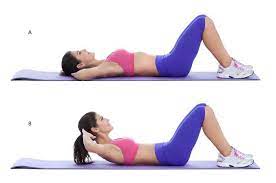
Leg Raises
- To do this exercise the patient has to take the supine lying with the legs extended.
- The core should be engaged & bring the legs up towards the sky as much as you can.
- Slowly lower the legs back towards the floor.
- Repeat for 10 to 15 repetitions for 2 to 3 sets.

Alternating Leg Raises
- How to do this strengthening exercise: To perform this exercise the patient has to Lie down on the back.
- Straighten the legs, contract the core & bring one leg up off the floor as much as possible.
- Slowly lower the leg back to the floor then raise the other leg up.
- The core should be engaged throughout the movement.
- Repeat for 10 to 15 repetitions for 2 to 4 sets in a day.


Pallof Press
- How to do this strengthening exercise: To perform this exercise the patient has to use the resistance band or cable machine in the gym stand at the distance & where the band/cable is taut at chest height.
- The anchor point should be to the side while the patient holds the band/cable with both hands and then presses straight out in front of you.
- The core should be engaged throughout the motion as you pause for 3 seconds while the arms are out straight before bringing them back to the chest. Repeat for 10 to 20 repetitions for 2 to 3 sets in one day.

Heel Touches
- How to do this strengthening exercise: To perform this exercise Lie down on the back with the knees flexed & feet on the floor.
- The back should be on the ground, crunch upbringing the shoulders up off the floor.
- Alternate side by side reaching down to touch the heels making sure to keep the abdominals contracted throughout the motion.
- Repeat for 10 to 20 repetitions for 2 to 3 sets in one day.
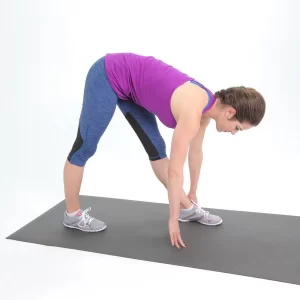
Posterior Pelvic Tilts
- How to do this strengthening exercise: To perform this exercise take the supine lying position with the knees flexed & feet on the floor.
- Gently draw the navel toward the spine to contract the lower abdominal muscles (the ones used when laughing/coughing).
- Tilt the pelvis, slightly lift the glutes off the ground, and press the upper back to the ground without holding your breath.
- Hold this position for 5 seconds.
- Repeat for 10 to 20 repetitions for 2 to 3 sets in one day.
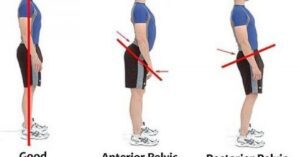
When did the patient not do the Transverse abdominis strengthening exercise?
- If the doctor advised you to take rest.
- If the patient is recently undergone abdominal surgery.
- If the patient feels any pain or even discomfort while these exercises.
- If the patient has acute back pain, he can take advice from a Physiotherapist before doing any exercise.
FAQ
Planks are the classic way to target the transversus abdominis, but the study by Australian researchers found that “the inward movement of the abdominal wall in supine” (a.k.a. performing the hollow hold) produces potentially even greater muscle activation
Like with the deadlift, any kind of squat variation will work the transverse abdominis, says Fagan. The core needs to remain tight & engaged as you lower down with the weight and push back up.
Typical signs of a weak transversus abdominis are toned abdominals above the navel but a bulge below it. The client may experience an inability to hold in the stomach after a large meal or when gassy; low back fatigue after prolonged standing or walking.
A weak transverse abdominis may lead to low back pain. When your TrA is weak, it is unable to do its job of stabilizing the pelvis & spine. This creates postural instabilities that can cause pain in the lower back.
The transverse abdominis is located in the abdomen immediately inside of the internal oblique muscle. It is one of the innermost muscles of the abdomen and it arises from the inguinal ligament, iliac crest, the inner surfaces of the lower six ribs, and from the thoracolumbar fascia.
What if the goal is weight loss or burning fat around the abdomen, would the patient squat or plank? Most probably recommend squatting because you’ll burn more energy overall. And have the benefit of building both leg and core strength in a way that has more real-world application.

